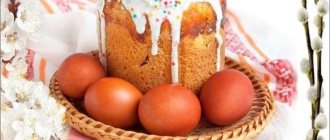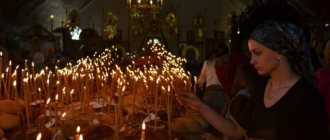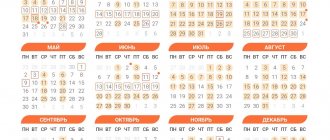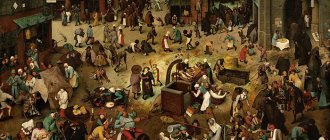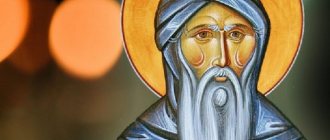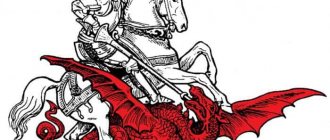The date of Easter celebration changes every year, but Orthodox Christians probably know what date they celebrate Maslenitsa, Easter, Palm and Forgiveness Sunday in 2022. After the Nativity of Christ and Christmastide, we begin to prepare for the onset of Lent. For four weeks, sermons will be heard in churches about the famous parables of Christ: the publican and the Pharisee, the prodigal son, and the Last Judgment. This reminds us that we are all on earth only guests, and our whole life is the path to the Kingdom of Heaven.
Lent is considered the most important season for the Russian Orthodox Church. This is the longest period for which believers limit themselves to food and lead a very special lifestyle.
The Holy Resurrection of Christ is celebrated in the spring - from year to year, the day of celebration is calculated according to a special church calendar.
EASTER or CHRIST'S RESURRECTION?
It would seem that the meaning of Easter - as we usually call our main holiday - is quite transparent. Alas! Experience tells a different story. I will give only two of the most typical examples.
A lesson in one “Orthodox gymnasium”. Wanting to identify the level of knowledge of the children, I ask: “How did Christ and the apostles celebrate Easter?” – A reasonable answer follows: “They ate Easter cakes and colored eggs”! There is nothing to object to this! What about the adults?
Easter night breaking the fast in one church. Indeed, we eat eggs and Easter cakes (and not only). “Suddenly” an important thought occurs to one already middle-aged singer, and he turns in confusion to the priest (with a theological education). “Father! So we keep singing and singing “Christ is Risen!”, and call the holiday “Easter”! So, after all, Jews celebrate Easter, but do not believe in Christ at all! Why is that?!"
This is no exception: what we perceive from childhood on an everyday level as some kind of beautiful ritual seems to us to be self-evident and does not require study.
Let’s give ourselves an “Easter lesson” and ask: what associations does the Easter greeting “Christ is Risen!” give rise to in our minds? - “Truly he is risen!”
A night religious procession with candles, everyone will immediately answer, joyful singing and mutual kisses. Dishes familiar from childhood appear on the home table - red and painted eggs, rosy Easter cakes, vanilla-scented Easter cottage cheese.
Yes, but this is only the external attributes of the holiday, a thoughtful Christian will object. – And I want to know why our holiday of the Resurrection of Christ is usually called the Hebrew word “Easter”? What is the connection between Jewish and Christian Passover? Why did the Savior of the world, from whose birthday humanity begins to count the New Era, have to die and be resurrected? Couldn't the all-good God have established a New Union (Covenant) with people in a different way? What is the symbolism of our Easter services and holiday rituals?
Easter table
Easter is preceded by the Great Lent of forty days, during which those fasting abstain from alcohol and food of animal origin. On the Bright Resurrection of Christ the breaking of the fast begins. Believers are allowed to consume fast food and red wine. Housewives prepare holiday treats the day before. Traditional dishes are: jellied meat, homemade sausages, lard, baked young pig, goose stuffed with apples, pies with meat and cheese fillings. At the festive meal, the central place is occupied by Easter cakes, Easter cottage cheese, and colored eggs. Eggs are colored with artificial or natural dyes and decorated with designs and Easter greetings. The traditional color is red.
Housewives cover the festive table with a new white tablecloth, embroidered on an Easter theme. A dish with the largest and most beautiful Easter egg and eggs around is placed in the center. Flowers are placed on the table and candles are lit. It is necessary to start the meal with foods consecrated in the church.
Prototypes: “Earthly Easter”
“Observe the month of Abib (Nisan), and keep the Passover to the Lord your God, for in the month of Abib the Lord your God brought you out of Egypt by night” (Deuteronomy 16:1)
The historical and symbolic basis of the Jewish Passover is the epic events of the book of Exodus. It tells about the four-century period of Egyptian slavery, in which the Jewish people were oppressed by the pharaohs, and the wonderful drama of their liberation. Nine punishments (“plagues of Egypt”) were brought down on the country by the prophet Moses, but only the tenth made the cruel heart of the pharaoh soften, who did not want to lose the slaves who were building new cities for him. It was the defeat of the Egyptian firstborns, which was followed by the “exodus” from the House of Slavery. At night, while waiting for the exodus to begin, the Israelites eat their first Passover meal. The head of each family, having slaughtered a one-year-old lamb (lamb or kid), anoints the doorposts with its blood (Ex. 12:11), and the animal itself, baked on the fire, is eaten, but so that its bones are not broken.
“Eat it this way: let your loins be girded, your sandals on your feet, and your staffs in your hands, and eat it with haste: this is the Passover of the Lord. And this very night I will walk through the land of Egypt and will strike every firstborn in the land of Egypt, from man to beast, and will bring judgment on all the gods of Egypt. I am the Lord. And your blood will be a sign on the houses where you are; and I will see the blood and pass by you, and there will be no destructive plague among you when I strike the land of Egypt” (Ex. 12:11-13).
So on the night of the first spring full moon (from the 14th/15th month of Abib, or Nisan) in the 2nd half of the 13th century before the birth of Christ, the exodus of the Israelites from Egypt took place, which became the most important event in Old Testament history. And Easter, which coincided with deliverance, became an annual holiday - a remembrance of the exodus. The very name “Passover” (Heb. Pesah - “passing”, “mercy”) indicates that dramatic moment (“tenth plague”) when the angel of the Lord who struck Egypt, seeing the blood of the Passover lamb on the doorposts of Jewish houses, passed passed by and spared the firstborn of Israel (Ex. 12:13).
Subsequently, the historical character of Easter began to be expressed by special prayers and a story about its events, as well as a ritual meal consisting of lamb meat, bitter herbs and sweet salad, which symbolizes the bitterness of Egyptian slavery and the sweetness of newfound freedom. Unleavened bread reminds us of hasty preparations. Four cups of wine accompany the Easter meal at home.
The night of the exodus became the second birth of the Israeli people, the beginning of its independent history. The final salvation of the world and victory over the “spiritual slavery of Egypt” will be accomplished in the future by God’s Anointed One from the line of King David - the Messiah, or, in Greek, Christ. This is how all the biblical kings were called at first, but the question of who would be the last in their ranks remained open. Therefore, every Passover night the Israelites waited for the appearance of the Messiah.
Easter calendar until 2030
You can find out when Easter is celebrated by counting. It is already known what date the celebration will take place next year. For Russia, the traditions of counting moving holidays remain unchanged. For 2022, April 24 falls, and then the dates shift.
| 2023 | April 16 |
| 2024 | 5 May |
| 2025 | 20 April |
| 2026 | 12th of April |
| 2027 | May 2 |
| 2028 | April 16 |
| 2029 | April 8 |
| 2030 | April 28 |
Performance: “Heavenly Easter”
“With all my heart I wished to eat this Easter with you before My suffering! I tell you, I will not eat it again until it is completed in the Kingdom of God” (Luke 22:15-16)
The Messiah-Christ, who came to deliver all people from the spiritual “slavery of Egypt,” takes part in the Jewish “Passover of expectation.” He completes it by fulfilling the Divine plan inherent in it, and thereby abolishes it. At the same time, the nature of the relationship between God and man changes radically: the temporary Union of God with one people, which has fulfilled its purpose, becomes “old” (“outdated”), and Christ replaces it with the New – and eternal! – Union-Covenant with all humanity During His last Passover at the Last Supper, Jesus Christ utters words and performs actions that change the meaning of the holiday. He Himself takes the place of the Passover sacrifice, and the old Passover becomes the Passover of the new Lamb, slain for the purification of people once and for all. Christ institutes a new Easter meal - the sacrament of the Eucharist - and tells the disciples about His imminent death as an Easter sacrifice, in which He is the New Lamb, slain “from the foundation of the world.” Soon He will descend into gloomy Sheol (Hades) and, together with all the people waiting for Him there, will make the great Exodus from the kingdom of death to the shining Kingdom of His Father. It is not surprising that the main prototypes of the Calvary sacrifice are found in the ritual of the Old Testament Easter.
The Passover lamb (lamb) of the Jews was “male, without blemish” and was sacrificed on the afternoon of the 14th of Nisan. It was at this time that the Savior died on the cross. Those executed had to be buried before dark, so the Roman soldiers, in order to speed up their death, broke the legs of two robbers who were crucified with the Lord. But, “coming to Jesus, they saw that He was already dead, and they did not break His legs<...>. For this happened in fulfillment of the Scripture: “Let not His bone be broken” (John 19:33, 36). Moreover, the very preparation of the Paschal lamb was a prototype of the Savior’s death on the cross: the animal was “crucified” on two cross-shaped stakes, one of which ran along the ridge, and the front legs were tied to the other.
This deepest relationship between the old and new Easter, their concentration (the abolition of one and the beginning of the other) in the person of Jesus Christ explains why the holiday of His Resurrection also retains Easter . “Our Passover is Christ sacrificed,” says the Apostle Paul (1 Cor. 5:7). Thus, in the new Easter, the final completion of the Divine plan for the restoration of fallen (“old”) man to his original, “paradise” dignity took place—his salvation. “The Old Easter is celebrated because of the salvation of the short-term life of the Jewish firstborn, and the new Easter is celebrated because of the granting of eternal life to all people,” this is how Saint John Chrysostom succinctly defines the relationship between these two celebrations of the Old and New Testaments.
Lent in 2022: from what date to what date
Based on the dates of Maslenitsa and Easter, you can determine the start and end dates of Lent. The day after the end of Maslenitsa week, Lent begins, which lasts 40 days. And it ends with Easter.
Since Easter falls on Sunday 24 April in 2022, Lent will last from Monday 7 March to Saturday 23 April. Taking these dates into account, Maslenitsa week will begin on Monday, February 28, and end on Sunday, March 6.
Lent is the strictest fast observed by Orthodox Christians. It consists of Lent - 40 days - and Holy Week - the week before Easter itself.
The strict weeks of Lent are the first and last weeks:
- March 7-14, 2022 - the first week of Lent.
- April 16-23, 2022 - Holy (last) week of Lent.
The basic rules of Lent are abstinence from foods containing animal fats (meat and processed foods), dairy products, eggs, and alcohol.
On Mondays, Wednesdays and Fridays you cannot eat foods that have been thermally processed. Hot meals are allowed on Tuesdays and Thursdays. Fish is allowed to be eaten for only 2 days during Lent - on the feast of the Annunciation of the Blessed Virgin Mary and on Palm Sunday.
Immediately after Lent, Orthodox Christians celebrate Easter.
Easter is a forty-day holiday
The Day of the Bright Resurrection of Christ - as “a holiday and a triumph of celebrations” (Easter chant) - requires special preparation from Christians and is therefore preceded by Great Lent. The modern Orthodox Easter (night) service begins with the Lenten Midnight Office in the church, which then turns into a solemn procession of the cross, symbolizing the myrrh-bearing women who walked to the Savior’s Tomb in the pre-dawn darkness (Luke 24:1; John 20:1) and were informed of His resurrection in front of the entrance to the tomb cave. Therefore, the festive Easter Matins begins in front of the closed doors of the church, and the bishop or priest leading the service symbolizes the angel who rolled away the stone from the doors of the Tomb.
Joyful Easter greetings end for many on the third day or with the end of Easter week. At the same time, people perceive Easter greetings with surprise and embarrassedly clarify: “Happy belated Easter?” This is a common misconception among non-church people.
It should be remembered that Bright Week does not end the celebration of the Resurrection of Christ. The celebration of this greatest event for us in world history continues for forty days (in memory of the forty-day stay on earth of the Risen Lord) and ends with the “Giving of Easter” - a solemn Easter service on the eve of the Ascension. Here is another indication of the superiority of Easter over other Christian celebrations, none of which are celebrated by the Church for more than fourteen days. “Easter rises above other holidays, like the Sun above the stars,” St. Gregory the Theologian reminds us (Conversation 19).
"Christ is Risen!" - “Truly He is Risen!” - we greet each other for forty days.
Yu. Ruban
* * *
“Christ is Risen!”: Easter customs and traditions
At midnight on Sunday, festive services begin in churches and temples, which are accompanied by the ringing of bells. This joyful announcement of the Resurrection of Christ gathers people for the Easter service. Whole families go to church, wearing their best clothes and taking wicker baskets with Easter cakes and colored eggs.
According to tradition, believers, led by a priest, walk around the church. In honor of the joyful event, churches change the decoration of the temple Calvary (wooden crucifix) from black to white. If you are at home the night before Great Easter 2021, light the candle that you brought from church on Palm Sunday.
Services in the church will last until the morning, their culmination will be the blessing of Easter baskets with holiday cakes, colored eggs and wine. Everyone around rejoices and begins to christen themselves, greeting each other with the words “ Christ is Risen!” “In response to congratulations, you should answer: “In truth he is risen!” Also, in honor of the holiday, when people meet, they kiss three times and exchange dyed eggs (colored chicken eggs).
After the service, all family members gather at home at the festive table to break their fast. Lent is over: you can already feast on meat dishes, try Easter cakes and have an Easter egg beating. This tasty and fun game is especially loved by children who strive to break their opponent’s egg. According to the rules, the winner gets the opponent's paint and the title of champion until the next battle.
Questions about Easter
• What does the word “Easter” mean?
• Why do they celebrate Easter if Easter was celebrated before the birth of Jesus Christ?
• How is the date of Easter calculated? Why is it celebrated on different days?
• Where were the saints and righteous people before the Resurrection of Christ - in Paradise or in hell?
• At what point in the service on Saturday does Holy Saturday end and Easter begin?
• In the Orthodox community, there is an opinion that if a person died on Easter day, then his ordeal is easier. Is this a popular belief or church practice, tradition?
• Why is it customary to paint eggs at Easter? What colors are acceptable? Is it possible to decorate Easter eggs with stickers with icons? What is the correct way to deal with shells from blessed eggs?
• How and for how long is Easter celebrated?
• Is it possible to congratulate people of other faiths on Easter?
• Is it possible to work and clean on Easter days?
• What is the tradition of consecrating bread—artos—connected with?
Holy Fire
On Holy Saturday, on the eve of Easter, the descent of the Holy Fire takes place in the Jerusalem Church of the Resurrection. The temple was built on Mount Golgotha, where Jesus was crucified, and on the site of the Holy Sepulcher - a stone cave where he was buried.
The fire is taken out during the service from the Edicule - a chapel inside the temple. The Greek Patriarch passes it on to other patriarchs, after which it is distributed throughout the temple. Every year, more than 15 thousand parishioners take part in the ceremony, holding in their hands bundles of 33 candles - a symbol of the years of Christ’s life. The service in the Church of the Resurrection is broadcast in many countries around the world.
From Jerusalem the Holy Fire is transmitted to other states. In 1992, after an 80-year break, it was delivered to Moscow. Since that time, every year the Holy Fire is transferred by plane to the capital of Russia and spreads to other cities of the country.
What does the word "Easter" mean?
The word “Passover” (Pesach) literally translated from Hebrew means: “passing by”, “transition”.
During the Old Testament, this name was associated with the exodus of the children of Israel from Egypt. Since the ruling pharaoh opposed God’s plan to leave Egypt, God, admonishing him, began to successively bring down a series of disasters on the country of the pyramids (later these disasters were called “plagues of Egypt”).
The last, most terrifying disaster, according to God's plan, was to break the stubbornness of Pharaoh, finally suppress resistance, and induce him to finally submit to the Divine will.
The essence of this last execution was that all the firstborn among the Egyptians were to die, starting from the firstborn of livestock and ending with the firstborn of the ruler himself (Exodus 11:5).
A special angel had to carry out this execution. So that when it strikes the firstborn, it does not strike along with the Egyptians and Israelites, the Jews had to anoint the doorposts and lintels of the doors of their homes with the blood of the sacrificial lamb (Ex. 12:7). That's what they did. The angel, seeing houses marked with sacrificial blood, walked around them, “passed by.” Hence the name of the event: Easter (Pesach) - passing by.
In a broader interpretation, the holiday of Passover is associated with the Exodus in general. This event was preceded by the sacrifice and consumption of Passover sacrificial lambs by the entire community of Israel (at the rate of one lamb per family; if a particular family was small, it had to unite with its neighbors (Ex. 12:4)).
The Old Testament Passover lamb prefigured the New Testament Lamb, Christ. Saint John the Baptist called Christ the Lamb who takes away the sin of the world (John 1:29). The Apostles also called the Savior the Lamb, by whose Blood we were redeemed (1 Pet. 1:18-19).
After the Resurrection of Christ, Easter, among Christianity, began to be called a Holiday dedicated to this event. In this case, the philological meaning of the word “Easter” (transition, passage) received a different interpretation: the transition from death to life (and if we extend it to Christians, then as a transition from sin to holiness, from life outside of God to life in the Lord).
Little Easter is sometimes called Sunday.
In addition, the Lord Jesus Christ Himself is called Easter (1 Cor. 5:7).
When does the holiday start?
Every year the entire Orthodox world celebrates Easter. The Resurrection of Christ is a great holiday, lasting a whole week, it is preceded by Great Lent, lasting 48 days:
- the first part of forty days – Holy Pentecost (02.03.20-10.04.20);
- Lazarev Saturday (11.04.20);
- Palm Sunday (04/12/20);
- Holy Week (04/13/20-04/18/20).
The date of Easter Sunday marks the beginning of Great Lent, Holy Week (04/19/20-04/25/20), Trinity Week (06/07/20-06/13/20), and Radunitsa (04/28/20). The date of the church holiday changes every year, but according to the clock, Easter always arrives at the same time.
Great Lent ends exactly at 12 o'clock on Holy Saturday and Bright Sunday begins. A solemn service begins in all churches - Bright Easter Matins. It lasts until 3-4 am. After the service, you can celebrate the holiday and congratulate loved ones.
How is the date of Easter calculated? Why is it celebrated on different days?
According to Jewish religious tradition, during the Old Testament, the Passover of the Lord was celebrated annually on the 14th of the month of Nisan (Lev. 23:5).
On this day the slaughter of the Passover sacrificial lambs took place (Ex. 12:6). From the Gospel narrative it convincingly follows that the date of the Passion on the Cross and the death of the Messiah chronologically corresponded to the time of the Jewish Passover (John 19:31).
Despite the fact that Christ ate Easter with the apostles on Thursday, and He was Crucified only the next day, it is affirmed that He, like the New Testament Lamb (1 Pet. 1:18-19), accepted the Sacrificial Suffering of the Cross and Death not on the 15th, but on the 14th of Nissan: on the day on which the (Old Testament) Passover lambs were to be eaten.
The annual religious and festive cycle of the Jews, since the time of Moses, was tied not to the solar calendar, which has an average of 365.25 days, but to the lunar one. The length of the lunar year is about 354 days. Thus, it is shorter than the solar one by approximately 11 days. Due to this circumstance, in different years the same phases of the moon fall on different numbers of months tied to the solar calendar.
That is why the Jewish Passover, celebrated according to the lunar calendar always on the same day of the month of Nissan, according to solar calculation, moves from one date to another every year.
In the early days of Christianity, there was no unanimity regarding the day of Easter. In the Western and a number of Eastern regions, the Easter holiday was celebrated on the first Sunday following the day of the Jewish Passover. The Churches of Asia Minor celebrated Easter on the 14th of Nissan, on the same day as the Jewish Passover.
Sometimes disagreements between believers regarding this issue caused discord. At the First Ecumenical Council, held in 325 in Nicaea, the fathers, participants in this Council, determined to celebrate the Passover of Christ without fail after the Jewish one, on the next Sunday after the full moon, which falls on the very day of the vernal equinox or occurs immediately after it (but not earlier ).
If the March full moon occurs before the vernal equinox (March 21), the Easter full moon is considered to be already in March, but in April. If it falls, for example, on Sunday, April 18, then Easter is moved to the next Sunday, April 25. This is the latest date for celebrating Easter. The earliest day is March 22. This occurs when the March full moon falls on Saturday, March 21st.
The meaning of the holiday among Christians
The tradition of celebrating Easter does not begin with the Resurrection of Christ - it existed before that. The Jewish holiday of Passover was and is celebrated to commemorate the exit of the Israeli people from Egyptian captivity under the leadership of Moshe (Moses).
It just happened that the Savior rose from the dead on this very day. As you know, such coincidences may seem random only at first glance. The liberation of the Jewish people from captivity in Egypt is a story that is generally regarded as the liberation of all mankind from the power of sin and death.
The miraculous resurrection of Christ signifies the greatest victory of good over evil, a visible symbol of the fact that love and faith are much stronger than hatred and fear.
And just as the Jewish people sacrificed the Passover lamb, so the Lord himself sacrificed his son to the slaughter. And in this event the boundless love of God for man was manifested.
And even if a person has a neutral attitude towards the Easter holiday, this does not deprive him of the right to join the jubilant humanity, which will certainly utter the cherished words:
"Christ is risen!"
“Truly risen!”
WHERE DOES THE WORD “EASTER” COME FROM?
Interestingly, translated from Hebrew, the word “Pesach” means “passed by” or “passed by.” This means that one day God passed by the Jewish houses and destroyed only the homes of their oppressors - the Egyptians.
In our time, the symbolism of history is also obvious: good certainly triumphs over evil. The Lord removes oppression and frees man from sin. By accepting the sacrifice of Christ, absolutely any of us can count on forgiveness and understanding.
Where were the saints and righteous people before the Resurrection of Christ - in Paradise or in hell?
As is known, while primitive people preserved innocence and moral purity, their place of residence was a special well-maintained Garden - Paradise (Gen. 2:8).
However, having abused their natural perfections and their freedom, they violated the commandment of God, underwent corruption, became mortal and were expelled from the monastery away (Gen. 3:23-24). From then until the completion of the Atonement by the Lord Jesus Christ, all people, dying, descended in souls into. The path to the Kingdom of Heaven was closed to man.
Both sinners and righteous people went to hell (Gen. 37:35). Another thing is that the degree of torment experienced and the places of imprisonment of souls, depending on the degree of their sinfulness or righteousness, were different (Ezek. 32:18-23) (see for more details: Heaven and hell: two places or two states?).
From the parable of the rich man and Lazarus, it is known that there was a special area in hell - Abraham's bosom (Luke 16:22). The souls of those Old Testament people who especially pleased the Lord with their faith and virtues fell into this area. How contrasting the difference between their state and the state of sinners was, we see from the content of the same parable (Luke 16:23:26).
Sometimes the concept of “Abraham’s bosom” is also referred to the Kingdom of Heaven. And, for example, in the iconography of the Last Judgment, the image of the “womb...” is used as one of the most common and significant symbols of Paradise dwellings.
But this, of course, does not mean that even before the Savior crushed the gates of hell, the righteous remained in Paradise (Christ’s victory over hell took place after His Passion on the Cross and death, when He, while remaining in the body in the tomb, descended in Soul to the underworld of the earth (Eph. 4 :9)).
Although the righteous did not experience the severe suffering and torment that the fierce villains experienced, they were not involved in the indescribable bliss that they began to experience upon their liberation from hell and elevation to the Glorious Heavenly Villages.
We can say that in a sense, Abraham's womb served as a prototype of Paradise. Hence the tradition of using this image in relation to the Heavenly Paradise opened by Christ. Now everyone who seeks salvation can inherit the Kingdom of Heaven.
At what point in the service on Saturday does Holy Day end and Easter begin?
On Saturday evening, usually an hour or half an hour before midnight, as the abbot decides, a pre-festive midnight office is celebrated in churches.
Despite the fact that in separate manuals the sequence of this service is printed together with the celebration of Holy Pascha, according to the Charter, it also refers to the Lenten Triodion. The vigil before Easter emphasizes the importance and significance of the expectations of the coming Triumph. At the same time, it recalls the vigil of the people of God (the sons of Israel) on the night before their departure from Egypt (we emphasize that the Old Testament Passover sacrifice, which prefigured the Sacrifice of Christ on the Cross, was connected with this event).
Continuing the Midnight Office, incense is performed around the shroud, after which the priest, lifting it onto his head, takes it (Face to the East) to the altar (through the Royal Doors). The Shroud is placed on the Throne, after which incense is performed around it.
At the end of this service, there is a Procession of the Cross (to commemorate how the Myrrh-Bearing Women walked with aromas to the Tomb of the Savior), and then Easter Matins takes place.
At the end of the procession, believers stand with reverence in front of the temple gates, as if before the Holy Sepulcher.
Here the rector begins Matins: “Glory to the Saints...”. After this, the air is filled with the sounds of the festive troparion: “Christ is risen from the dead”...
Parents' Saturdays
On the eve of the beginning of Lent, you can submit notes “for Great Lent,” both about the health and the repose of relatives and loved ones. They are read by clergy during weekday services. However, the peculiarity of Lent is that during it the full liturgy, with the removal of particles from the prosphora for the repose of deceased Christians, is performed only on Saturdays and Sundays.
Thus, the dead seem to be somewhat deprived of church prayer. Caring for her children who are in another world, the Church from ancient times established three Saturdays during Lent, called by the people Parents' Days. This is the second, third, fourth Saturday of Lent.
How and for how long is Easter celebrated?
Easter is the oldest church holiday.
It was established during the time of the apostles. Thus, Paul, inspiring his brothers in faith to a worthy, reverent celebration of the Day of the Resurrection of Christ, said: “Purge away the old leaven, so that you may be a new lump, since you are unleavened, for our Passover, Christ, was sacrificed for us” (1 Cor. 5: 7). It is known that the early Christian Church united under the name Easter two weeks adjacent to each other: the one preceding the day of the Resurrection of the Lord and the following. Moreover, the first of the designated weeks corresponded to the name “Easter of Suffering” (“Easter of the Cross”), while the second corresponded to the name “Easter of the Resurrection.”
After the First Ecumenical Council (held in 325 in Nicaea), these names were forced out of church use. The week preceding the day of the Resurrection of the Lord was given the name “Passionate”, and the week following it – “Bright”. The name “Easter” was established after the Day of the Resurrection of the Redeemer.
Divine services during Bright Week are filled with special solemnity. Sometimes the entire week is referred to as one Bright Feast of Easter.
In this Christian tradition one can see a connection with the Old Testament rite, according to which the holiday of the (Jewish) Passover was combined with the Feast of Unleavened Bread, which lasted from the 15th to the 21st of the month of Nisan (on the one hand, this holiday, celebrated annually, was supposed to remind the children of Israel of the events of the exodus their people from Egypt; on the other hand, it was associated with the beginning of the harvest).
Continuing Bright Week, services in churches are carried out with the Royal Doors wide open - in commemoration of the fact that the Savior, through the Resurrection, victory over hell and death, opened the gates of Heavenly Paradise to people.
Easter is celebrated on Wednesday of the 6th week, in accordance with the fact that before the Day of His Ascension, the Lord who rose from the Tomb, walking on the earth, showed himself to people, testifying to His Resurrection.
There are six weeks in total until the day of Easter: the first is Easter; second - Fomina; the third - the holy myrrh-bearing women; the fourth is about the paralytic; the fifth is about the Samaritan woman; the sixth is about a blind man.
During this period, the Divine dignity of Christ is especially glorified, the miracles He performed are remembered (see: Miracle), confirming that He is not just a Righteous Man, but God Incarnate, Who Resurrected Himself, trampling death, crushing the gates of the kingdom of death, for the sake of our Salvation.
Easter signs and beliefs
It has long been believed that on Easter you can ask God for anything.
- The girls asked for a groom, the elderly - for health for themselves and for the imminent birth of grandchildren.
- On Easter Sunday, you should get up before dawn so as not to oversleep your happiness.
- Young girls washed themselves with water from a red egg to look rosy.
- The top of the blessed Easter cake was saved until the sowing season. The owner ate it after completing spring field work in order to get a good harvest.
Is it possible to congratulate people of other faiths on Easter?
Easter of Christ is the most solemn and great Feast of the Universal Church (according to the metaphorical statement of the Holy Fathers, it is as superior to all other Church Holidays as the radiance of the sun is superior to the radiance of the stars).
Considering that the Son of God came into the world, became incarnate, taught, suffered, died on the Cross and was resurrected for the salvation of all people without exception, we can say with confidence that the Easter of Christ, to one degree or another, concerns every person (whether a Christian or atheist): the doors of the Kingdom of Heaven open, through faith, for everyone.
In this regard, to greet non-believers and even atheists with the words of the Easter proclamation “Christ is risen!” Can. In principle, this is not prohibited by God's law. After all, this greeting contains the main idea of the Apostolic Sermon, which sounded, according to the word of Christ, throughout the entire ecumene, for all the peoples of the earth (Matthew 28:19-20).
Thus, Equal-to-the-Apostles Mary Magdalene, visiting Rome, greeted the pagan emperor Tiberius with precisely this proclamation. “Christ is risen!” she told him, and presented him with a red egg as a gift.
Another thing is that not every non-religious (or atheist) is ready to react to Easter greetings (if not with joy, then at least) calmly. In some cases, this kind of greeting can provoke irritation, rage, violence and anger.
Therefore, sometimes, instead of an Easter greeting to this or that person, it is appropriate to literally fulfill the words of Jesus Christ: “Do not give what is holy to dogs, and do not throw your pearls before swine, lest they trample them under their feet and turn and tear you to pieces” (Matt. 7:6).
Here it is good to take into account the experience of the Apostle Paul, who, by his own admission, preaching the faith of Christ, tried to adapt to the circumstances and psychological state of people, being for the Jews - like a Jew, for the sake of gaining the Jews; for those under the law - as under the law, for the sake of acquiring those under the law; for those who are strangers to the law - as a stranger to the law (without being, however, himself a stranger to God's law) - in order to win those who are strangers to the law; for the weak - as the weak, for the sake of gaining the weak. He became all things to all, in order to save at least some of them (1 Cor. 9:19-22).
Interesting traditions of the Russian people
In Rus', the meeting of Christ's Resurrection has always been associated not only with solemn services, but also with mass merry celebrations with round dances, games, songs and dances. The bulk of song and dance “numbers” remain only in modern folklore ensembles. But the round dance (the personification of the solar life-giving circle that came from paganism) is still alive today, and is actively used during modern mass celebrations.
A favorite entertainment-competition was the now almost obsolete game with eggs:
- “rollers” - rolling colored eggs down a hill (it was important not to knock someone else’s egg and not break your own - a bad omen);
- torsion of eggs - whoever lasts longer is the winner, and he gets to take the fallen “trophy”;
- rolling paints towards each other - didn’t knock them down, rolled them - won.
Paint eggs
The festive Easter meal began with colored eggs thousands of years ago and now. Nowadays paints are rarely made by hand; they can be bought in stores, and in completely different colors and shades. But the traditional Easter color is shades of red.
This color was chosen by the ancestors of the Slavs in pre-Christian Rus', as a symbol of the Red Sun, which gives warmth, and therefore life, to all living things. And baptized Russians. The red color was identified with the martyr's blood of Christ, which he gave voluntarily for the salvation of mankind, and which was shed on the stone of the tomb in which he was later resurrected.
The blue color, introduced into the permitted coloring of eggs, symbolizes divine truth, green - fertility, yellow - faith.
Easter cake oven
Initially, a tall, tapering ritual pastry was baked by pagan ancestors for the spring equinox, dedicating it to the masculine principle that awakens life. The white fondant (icing) represented the viviparous seed. Multi-colored powder (poppy seeds, grains) – the fertility of Mother Earth. The raisins inside the Easter cake are the fruits that are born in its womb.
Christianity “purified” pagan baking by changing the tripartite symbolism to the divine essence of the Holy Trinity.
The characteristic shape of the bread, according to one version, is a stylization of the dome of a Christian temple; according to another, it is the embodiment of the outline of the stone that sealed the entrance to the tomb of Christ, through which the world was given a visible foreshadowing of the resurrection of the Son of God - the Holy Fire.
Beat eggs
Celebrations of the Lord's Resurrection meant joyful meetings. But now we can hug each other and kiss each other in public. Previously, such “frank” behavior was strongly condemned. Therefore, Christians “invented” egg “kissing” - they hit each other three times with dyed eggs, congratulating each other. This is the everyday version of the origin of the custom.
There is also a religious interpretation. It is connected with the stone of his tomb, reddened by Christ’s blood. Each blow of a believer’s egg, as it were, helps Jesus come out of the crypt and announce his resurrection to his disciples, followers - the whole world.
Is it possible to work and clean on Easter days?
It is customary to prepare for Easter in advance.
This means that the work that can be done in advance is better done in advance. It is better to postpone work that is not related to the Holiday and does not require immediate completion (for the duration of the Holiday). So, for example, the ancient Christian monument “Apostolic Constitutions” gives a firm instruction that neither in Holy Week, nor in the following Easter (Bright) Week, “let not slaves work” (Apostolic Constitutions. Book 8, Chapter 33)
However, there is no unconditional, unrelated to circumstances, ban on any kind of work at all during the Easter period.
Suppose there are many types of professional, official and social activities that require the indispensable participation of one or another person, regardless of his desire and the church calendar.
This type of activity includes: law enforcement, military, medical, transport, fire fighting, etc. Sometimes, in relation to this type of work on the Feast Day, it is not superfluous to remember the words of Christ: “render to Caesar the things that are Caesar’s, and to God the things that are God’s” (Matthew 22:21).
On the other hand, exceptions regarding work can occur even when it comes to such everyday work as cleaning the house or washing dishes.
In fact, is it really possible that if during the Easter holiday the table is filled with dirty plates, spoons, cups, forks, food waste, and the floor suddenly inappropriately floods with some kind of drink, all this will need to be left as is until the end of the Easter celebrations?
What not to do on Easter Sunday
Of course, there are obvious recommendations that apply to any holiday, and especially the holy holiday of Easter:
- You shouldn’t sort things out or start important business conversations on such a day.
- It is better to refrain from unpleasant memories and everything that literally darkens the Resurrection of Christ. It is important to understand that Easter is a day of joy, not sorrow. Believers remember not the deceased, but the risen Savior.
- You should not indulge in gluttony and drink. Of course, no one denies themselves food, and a couple of glasses of nice red wine won’t hurt. We must remember what the main food is on such a day - spiritual, not earthly.
- It is not advisable to clean up, do repairs, visit beauty salons, wash windows, etc. That is, all actions that distract from a pleasant celebration are undesirable. At the same time, there are no direct prohibitions on this. Everyone can act according to their own conscience. In addition, sometimes a person may find himself at work even on Christ’s Resurrection. And of course, he must fulfill his official duty.
- You should not visit cemeteries on such a day; you should choose a different time to honor the dead. Easter is the triumph of life over death, truth over sin. It’s better not to forget about this when we celebrate Easter.
Representatives of the Orthodox Church also express a similar opinion.
On the beautiful spring day of the Holy Resurrection of Christ, everyone can feel like they are part of something wonderful and eternal. After all, celebrating Easter is a great honor. This means coming into contact with sacred history - perhaps the main event in the history of mankind.


